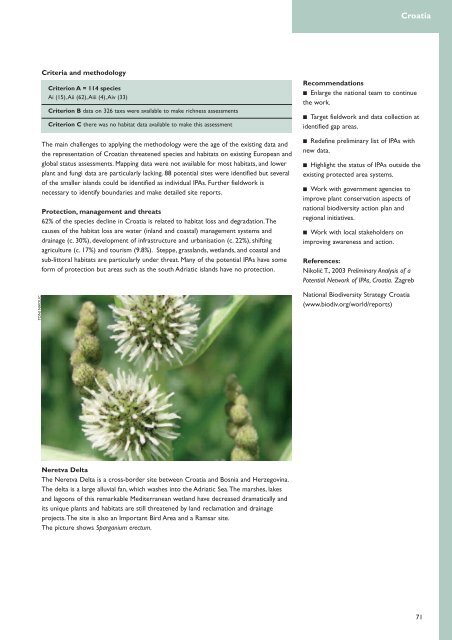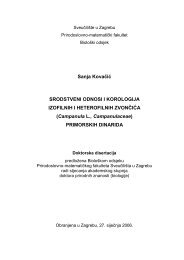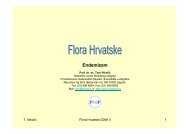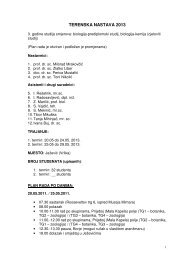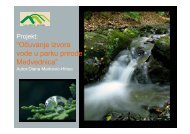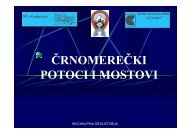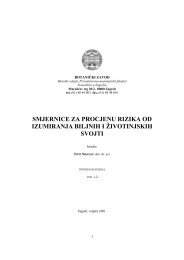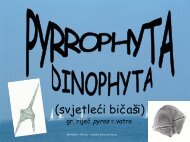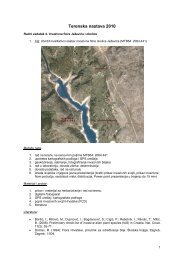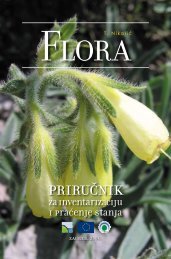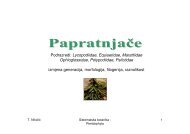important plant areas in central and eastern europe - hirc.botanic.hr ...
important plant areas in central and eastern europe - hirc.botanic.hr ...
important plant areas in central and eastern europe - hirc.botanic.hr ...
Create successful ePaper yourself
Turn your PDF publications into a flip-book with our unique Google optimized e-Paper software.
CroatiaTONI NIKOLICCriteria <strong>and</strong> methodologyCriterion A = 114 speciesAi (15),Aii (62),Aiii (4),Aiv (33)Criterion B data on 326 taxa were available to make richness assessmentsCriterion C there was no habitat data available to make this assessmentThe ma<strong>in</strong> challenges to apply<strong>in</strong>g the methodology were the age of the exist<strong>in</strong>g data <strong>and</strong>the representation of Croatian t<strong>hr</strong>eatened species <strong>and</strong> habitats on exist<strong>in</strong>g European <strong>and</strong>global status assessments. Mapp<strong>in</strong>g data were not available for most habitats, <strong>and</strong> lower<strong>plant</strong> <strong>and</strong> fungi data are particularly lack<strong>in</strong>g. 88 potential sites were identified but severalof the smaller isl<strong>and</strong>s could be identified as <strong>in</strong>dividual IPAs. Further fieldwork isnecessary to identify boundaries <strong>and</strong> make detailed site reports.Protection, management <strong>and</strong> t<strong>hr</strong>eats62% of the species decl<strong>in</strong>e <strong>in</strong> Croatia is related to habitat loss <strong>and</strong> degradation.Thecauses of the habitat loss are water (<strong>in</strong>l<strong>and</strong> <strong>and</strong> coastal) management systems <strong>and</strong>dra<strong>in</strong>age (c. 30%), development of <strong>in</strong>frastructure <strong>and</strong> urbanisation (c. 22%), shift<strong>in</strong>gagriculture (c. 17%) <strong>and</strong> tourism (9.8%). Steppe, grassl<strong>and</strong>s, wetl<strong>and</strong>s, <strong>and</strong> coastal <strong>and</strong>sub-littoral habitats are particularly under t<strong>hr</strong>eat. Many of the potential IPAs have someform of protection but <strong>areas</strong> such as the south Adriatic isl<strong>and</strong>s have no protection.Recommendations■ Enlarge the national team to cont<strong>in</strong>uethe work.■ Target fieldwork <strong>and</strong> data collection atidentified gap <strong>areas</strong>.■ Redef<strong>in</strong>e prelim<strong>in</strong>ary list of IPAs withnew data.■ Highlight the status of IPAs outside theexist<strong>in</strong>g protected area systems.■ Work with government agencies toimprove <strong>plant</strong> conservation aspects ofnational biodiversity action plan <strong>and</strong>regional <strong>in</strong>itiatives.■ Work with local stakeholders onimprov<strong>in</strong>g awareness <strong>and</strong> action.References:Nikolić T., 2003 Prelim<strong>in</strong>ary Analysis of aPotential Network of IPAs, Croatia. ZagrebNational Biodiversity Strategy Croatia(www.biodiv.org/world/reports)Neretva DeltaThe Neretva Delta is a cross-border site between Croatia <strong>and</strong> Bosnia <strong>and</strong> Herzegov<strong>in</strong>a.The delta is a large alluvial fan, which washes <strong>in</strong>to the Adriatic Sea.The marshes, lakes<strong>and</strong> lagoons of this remarkable Mediterranean wetl<strong>and</strong> have decreased dramatically <strong>and</strong>its unique <strong>plant</strong>s <strong>and</strong> habitats are still t<strong>hr</strong>eatened by l<strong>and</strong> reclamation <strong>and</strong> dra<strong>in</strong>ageprojects.The site is also an Important Bird Area <strong>and</strong> a Ramsar site.The picture shows Sparganium erectum.71


